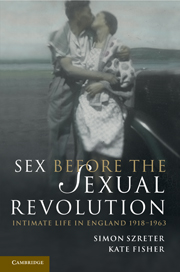Book contents
- Frontmatter
- Contents
- Acknowledgements
- 1 Introduction
- Part I What was sex?
- Part II What was love?
- 4 Romance and love: finding a partner
- 5 Married love: caring and sharing
- Part III Exploring sex and love in marriage
- 10 Conclusion: private lives
- Appendix A The oral history sample: summary of project design and socio-demographic characteristics of the interviewees in Blackburn and north-west Hertfordshire
- Appendix B Note on social classification of the respondents
- Appendix C
- Bibliography
- Index
- Index of interviewees
4 - Romance and love: finding a partner
Published online by Cambridge University Press: 05 June 2012
- Frontmatter
- Contents
- Acknowledgements
- 1 Introduction
- Part I What was sex?
- Part II What was love?
- 4 Romance and love: finding a partner
- 5 Married love: caring and sharing
- Part III Exploring sex and love in marriage
- 10 Conclusion: private lives
- Appendix A The oral history sample: summary of project design and socio-demographic characteristics of the interviewees in Blackburn and north-west Hertfordshire
- Appendix B Note on social classification of the respondents
- Appendix C
- Bibliography
- Index
- Index of interviewees
Summary
In generalised and cross-regional histories of Western culture and in sociological analyses it is assumed that young people approaching marriage in the first half of the twentieth century did so armed with a new set of ideas about love, sex and intimacy. New forms of consumer culture created a new emphasis on ‘expressivity, romantic attachment and erotic adventure’. In the first half of the twentieth century, it is argued, ‘sexual love, in advertising and film emerged as a utopia, wherein marriage could also be exciting, romantic, fun’. The rituals of courtship and the decisions to get married were transformed as ‘the emotional attachment between sexual partners, formed through “falling in love” [has become] understood as the basis of the relationship’. Distinctive in this vision was first the focus of marriage (as opposed to courtship) as the site for love and passion and second the centrality of sexual fulfilment to the ideal.
Numerous works, either drawing on literary studies or the techniques of social history, have explored these debates in a British context. Some of those historians who have drawn on cultural or literary sources have highlighted the prevalence of romantic narratives in contemporary fiction, marriage manuals, popular magazines and the cinema, which preached the ideal of falling in love with and marrying one's perfect ‘other half’. Karen Chow argues that films such as The Sheik, alongside the marriage manuals of Marie Stopes, offered women a new vision of female sexuality and male–female romantic interaction.
- Type
- Chapter
- Information
- Sex Before the Sexual RevolutionIntimate Life in England 1918–1963, pp. 165 - 195Publisher: Cambridge University PressPrint publication year: 2010



